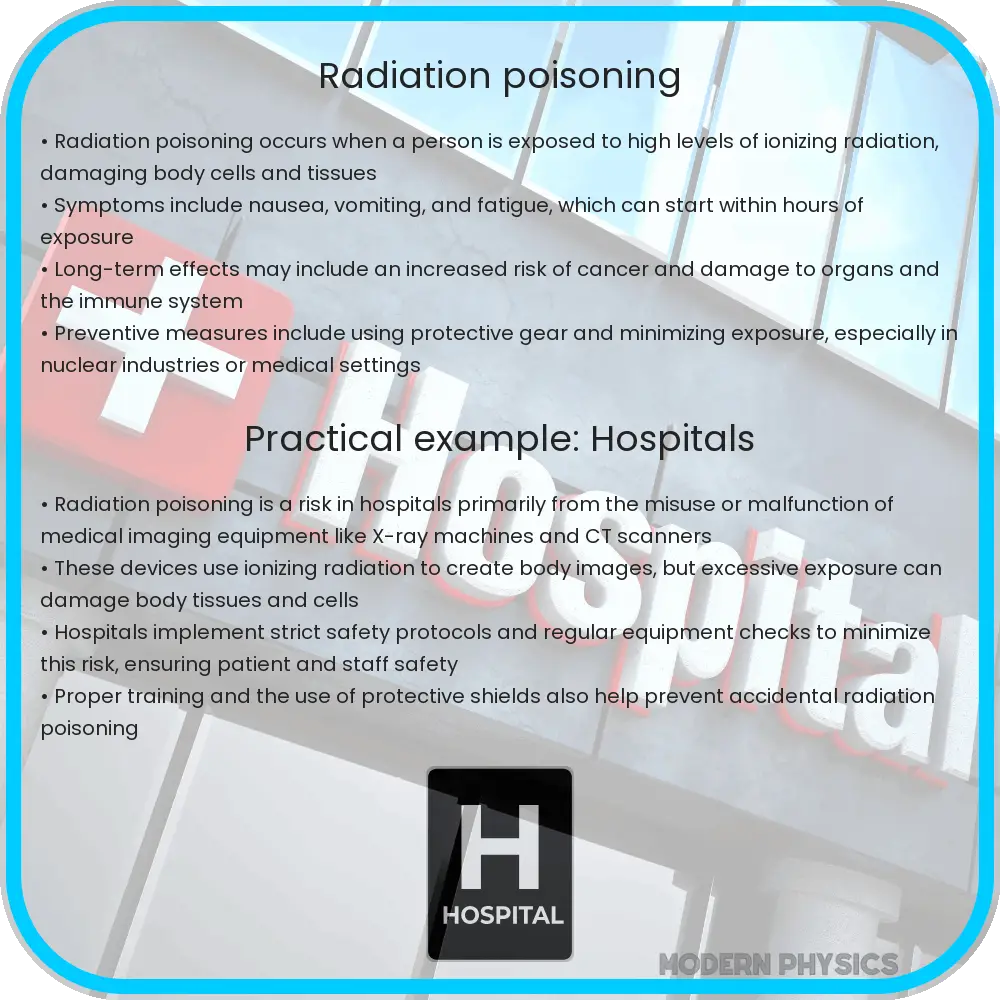Learn about radiation poisoning, its causes, symptoms, and prevention strategies to safeguard health against ionizing radiation exposure.

Understanding Radiation Poisoning
Radiation poisoning, also known as radiation sickness, occurs when a high dose of ionizing radiation penetrates the body and causes damage to tissues and cells. This article explores the causes, symptoms, and safety measures related to radiation poisoning.
Causes of Radiation Poisoning
Radiation poisoning can result from exposure to a significant amount of ionizing radiation, which is energy emitted from atoms in the form of electromagnetic waves or particles. These can be sourced from:
- Medical procedures: such as radiation therapy for cancer or large doses of diagnostic X-rays.
- Accidents: in nuclear power plants or mishandling of radioactive materials.
- Atomic bomb explosions: which release large quantities of radiation instantaneously.
- Occupational exposure: in fields such as radiology and nuclear industries where handling radioactive substances is routine.
It is important to note that not all radiation types are harmful. Ionizing radiation has enough energy to remove tightly bound electrons from atoms, thus creating ions. It is this ionizing radiation that poses health risks, unlike non-ionizing radiation (like radio waves or visible light).
Symptoms of Radiation Poisoning
The symptoms of radiation poisoning vary depending on the radiation dose and the duration of exposure. Initially, symptoms might include:
- Nausea and vomiting
- Headache
- Fatigue
- Fever
As exposure increases, more severe symptoms can manifest, such as:
- Skin burns and blisters
- Severe blood disorders
- Damage to the internal organs, particularly the bone marrow, lymph nodes, and spleen
- Neurological deficits that may progress rapidly
Symptoms can appear within hours of exposure to extremely high doses of radiation but might also be delayed in the case of lower doses. The timing and type of symptom can be crucial indicators of the severity of exposure.
Safety and Prevention Measures
To mitigate the risk of radiation poisoning, various safety and prevention measures can be implemented, especially in environments where exposure to ionizing radiation is likely. These measures include:
- Minimizing Exposure: Use of time, distance, and shielding methods to reduce exposure. This includes spending less time near radiation sources, increasing distance from the source, and using adequate shielding materials like lead or concrete.
- Safety Protocols: Adhering to strict safety protocols and guidelines, such as wearing protective gear and regular monitoring of radiation levels.
- Education and Training: Regular training for individuals working with or around radioactive materials to handle emergencies effectively.
- Medical Surveillance: Routine health check-ups for individuals exposed to higher than normal radiation levels to catch any adverse health effects early.
Understanding these fundamental aspects of radiation poisoning can enable individuals and professionals to take proactive steps in prevention and management, ensuring safer environments in both medical settings and industries involved with radioactive materials.
Treatment Options for Radiation Poisoning
Treatment for radiation poisoning focuses primarily on reducing and managing the immediate symptoms and preventing further radioactive contamination. Common approaches include:
- Decontamination: Removing radioactive particles from the body as quickly as possible to stop further radiation exposure.
- Medications: Administering drugs that can help protect the body’s cells from radiation damage or encourage the bone marrow to produce new blood cells.
- Supportive care: Providing treatments that address symptoms such as nausea, dehydration, and infections.
- Blood transfusions: Replacing damaged blood cells with healthy ones from donors.
- Stem cell transplant: In severe cases, transplanting stem cells can help repair damaged bone marrow.
Advanced medical treatment centers equipped with the necessary tools and expertise are crucial for effectively managing serious radiation injuries.
Historical Context and Awareness
The dangers of radiation have been known for decades, with incidents like the Chernobyl disaster and the bombings of Hiroshima and Nagasaki providing stark examples of the devastating health impacts from intense radiation exposure. These events have spurred increased public awareness and enhanced safety measures across various sectors.
Additionally, learning from past incidents has led to stricter regulatory standards and better safety practices in the handling and use of radioactive materials. This proactive approach helps minimize risks and protect individuals from potential radiation hazards.
Conclusion
Radiation poisoning, while serious and potentially life-threatening, is manageable through proper safety practices, immediate medical response, and ongoing education. Understanding the sources and health impacts of radiation can empower individuals to take appropriate preventive measures. Whether you are a medical professional, a worker in the nuclear sector, or simply an informed citizen, being cognizant of radiation safety protocols is fundamental.
By leveraging protective strategies, such as minimizing exposure, adhering to safety protocols, and seeking prompt medical treatment after exposure, the risks associated with radiation can be significantly reduced, fostering safer work and living environments. In sum, thorough preparation and knowledgeable handling of radiation sources are our best defenses against the potential dangers of radiation poisoning.
